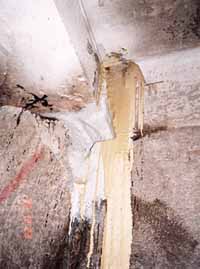![]()
Basement Waterproofing
Almost all basement structures are likely to be subjected to water pressure at some period of time. Thus concrete basements are vulnerable to the ingress of ground water through its substantial thickness of densest concrete, the construction joints and the cracks naturally borne with aging. Although designer will keep the construction joints to a minimum or may build a cavity wall in front of the diaphragm wall to separate the leaking water forever, it is inevitable that water will leaks through the weakest points like kicker joint and the floor slab of basement.
 Waterproofing works to basement is usually accomplished with
stopping persistent leaking water first. Skillful manipulation of quick-dry cement to
localize the seepage area to a few leaking points is important and then pipe nipples are
fixed to discharge leaking water to release water pressure at surrounding area. Once the
surface of the quick-dry cement gets dry, application of waterproofing cement or epoxy is
required to strengthen the waterproofing effect. Finally, water-reacting foam is rejected
via the pipe nipples to seal up the cracks or joints or even honey comb concrete. In some
case, discharge and collection of excess leaking water to slump pit is also practical.
Waterproofing works to basement is usually accomplished with
stopping persistent leaking water first. Skillful manipulation of quick-dry cement to
localize the seepage area to a few leaking points is important and then pipe nipples are
fixed to discharge leaking water to release water pressure at surrounding area. Once the
surface of the quick-dry cement gets dry, application of waterproofing cement or epoxy is
required to strengthen the waterproofing effect. Finally, water-reacting foam is rejected
via the pipe nipples to seal up the cracks or joints or even honey comb concrete. In some
case, discharge and collection of excess leaking water to slump pit is also practical.
Concrete is a porous material and if it is also required to prevent the entry of moisture vapour, an overall treatment is required to make the walls and floor slab completely impervious. Nowaday, a technology of crystalline formation by applying cementitious coating on the concrete surface is also introduced to block capillaries and shrinkage cracks in the concrete to drive out moisture. Anyway, epoxy injection to any cracks found in dry condition is the most proper maintenance to the basement.